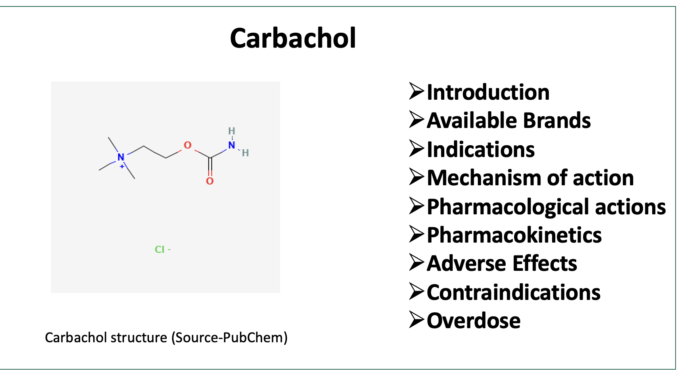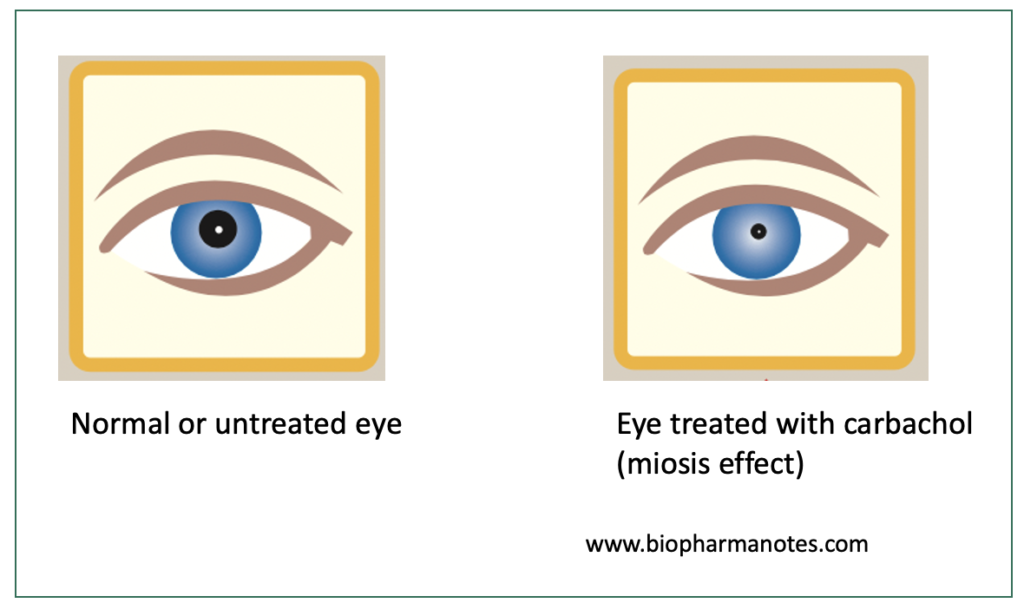
- Carbachol is ester of choline with carbamic acid which shows cholinergic (both muscarinic and nicotinic) actions. Carbachol is also known as carbamylcholine. It was discovered in 1932 and received its FDA approval in 1972.
- Chemically, carbachol is derivative of acetylcholine (esters of choline with acetic acid) and is positively charged quaternary ammonium compound.
Available brand names
- Carbastat, Miostat, Carboptic, Isopto carbachol
Indications of Carbachol
- Used as mitotic agent too treat glaucoma. It decreases IOP (intraocular pressure) and causes contraction of pupil.
- Recommended in patients who are allergic to pilocarpine and require miotic agent. IOP reduction property of carbachol is more compared to that of pilocarpine and it also has more side effects than pilocarpine.
- Used during cataract surgery to constrict pupil.
Mechanism of action
- It is a cholinergic agonist and mimics the action of acetylcholine on both muscarinic and nicotinic receptors.
- When administered through topical ocular and intraocular route, it causes contraction of ciliary body muscle and opens trabecular meshwork. Opening of meshwork increases outflow of aqueous humor and results in decrease of intraocular pressure.
Pharmacological actions of carbachol

- Due to its ganglionic stimulating activity, at beginning it stimulate GI (gastrointestinal) and CVS (Cardiovascular system) and then depress them. It also stimulates skeletal muscle and urinary bladder.
- When administered via parenteral route, it produces effects like salivation, lacrimation, sweating and flushing of face. When applied locally into eyes, it produces sustained mitotic effect and causes sustained contraction of ciliary muscle of eye.
Pharmacokinetics of carbachol
- When administered through oral route, it is poorly absorbed from GI tract. As it is hydrophilic, it is poorly absorbed from GI tract and doesn’t cross BBB (blood brain barrier). Hence, it is administered via ocular route (topical ocular or intraocular injection). Onset of action occurs within 2-5 minutes and its duration of action is 4-8 hours after topical administration and 24 hours after intraocular injection.
- It is a poor substrate for acetylcholinesterase and is resistant to action of both true and pseudocholinesterase. It undergoes slow metabolism by other esterase.
- In some formulation of carbachol, benzalkonium chloride is added to improve its corneal penetration property.
Available dosage form and strength
- Intraocular solution of carbachol is available as 0.01% solution and topical solutions are available either as 1.5 % or 3% solution.
Adverse effects
- Some of its severe side effects include visual impairment, bronchospasm, corneal opacification, retinal detachment etc.
- Some other moderate side effects are blurred vision, urinary retention, abdominal pain, diarrhea, hypersalivation, ocular pain, ocular irritation, headache etc.
Contraindications/ Warnings
- Contraindicated in patients with acute iritis.
- Contraindicated in patients hypersensitive to carbachol.
- Used with caution in patients with bronchial asthma and active peptic ulcer.
- Used with caution in patients with corneal abrasion as excessive penetration of drug through corneal abrasion can result in systemic toxicity.
- Should be used cautiously in cardiac patients, patients with hyperthyroidism, Parkinson’s disease, and urinary tract obstruction.
- If patient is wearing contact lenses, lenses need to be removed before applying carbachol ophthalmic solution.
- As carbachol produce miosis, it may cause difficulty in visual adaptation in low light or dark. So, while using carbachol one should be cautious if driving or using heavy machinery during night or low light.
- No sufficient data are available about safety of carbachol in pregnant and breastfeeding women, and in
Overdose
- Symptoms of overdose may include increased sweating, salivation, miosis, hypotension, nausea and bronchorrhea.
- In case of overdose, treatments like atropine, furosemide, epinephrine can be used.
References
- https://www.ncbi.nlm.nih.gov/books/NBK553130/
- https://www.rxlist.com/miostat-drug.htm#description
- https://go.drugbank.com/drugs/DB00411
- Becker-Shaffer’s Diagnosis and Therapy of the Glaucomas (8th Edition)
- Lippincott Illustrated Reviews Pharmacology, 6th edition.
- Pharmacology and pharmacotherapeutics. 24th edition.